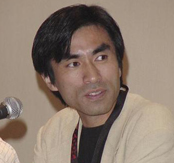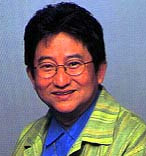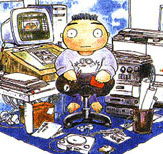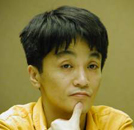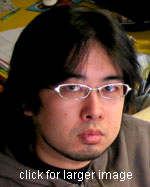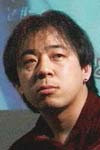Mecha Designers in Anime and Manga
This Web site would not be complete without a place to honor those who have made this hobby possible. Most mecha designers work long hours for little pay. Their work can be quite difficult as most assignments require them to make designs that would adapt well to cell animation, toys and plastic model kits. The GEARS staff believes 6 of these designers stand out as "greats" in their field due to either sheer genius or having had great influence on the genre. Where possible, links have been included to English language interviews with the designer. I’ve also provided the Japanese written characters for their names to help people identify names in the credits lists of anime and manga. Please let me know if you have any further information on these people or know of a link to an interview. Are there any more designers we should list here?
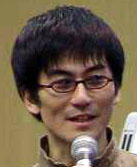
Katoki Hajime

Credits: Gundam Sentinel, Gundam 0083, Gundam Wing, G Gundam, Gundam 08th MS Team, V Gundam, Bandai MG kit range, Super Robot Wars Original Generation, Patlabor 2 (movie), Cyber Trooper Virtual On, Virtual On Oratorio Tangram
Katoki Hajime possesses amazing talent for mechanical design. Born in 1963, his numerous contributions to the Gundam universe have helped make it as long-lived as it is. With a careful eye for detail and a mastery of proportions Katoki was hired by Bandai to touch up the designs of many of the mecha from the Gundam universe for the Master Grade model kit series. I will always have a soft spot in my heart for his designs from Gundam Sentinel; only Katoki’s genius could bring the Ex-S Gundam to life.
Katoki’s designs usually have a blocky, sturdy look to them that has lead many fans to say his designs are the way giant robots should look. His excellent attention to detail makes him a wonderful illustrator for diagrams and cutaway views of mecha that help many people visualize his designs as real machines.
In his art book Gundam Fix the artist had this to say about mecha design. "Do people, like myself, spend time imagining what it would be like if Gundam robots were actually present on the streets of our cities? Are you sure you’re not limiting yourself to the images that were offered in the animated series? One of the reasons that I fell in love with Gundam was that it excites me to imagine what it would be like if these machines actually existed, and I worry that other fans may be losing out..." He said he hopes his work will catch peoples’ attention"...then people who had never before been drawn in by the magic of these giant robots may discover their attraction for the first time." Now that’s a true gearhead!
Famous Designs: RX-78 GP03 Dendrobium, XXXG-00W0 Wing Gundam Zero Custom
Kawamori Shoji

Credits: Macross, Macross Plus, Macross 7, Gundam 0083, Dangaioh, Patlabor 2, Crusher Joe, Armored Core, Cyber Formula, Escaflowne, Blue Submarine No. 6, Moldiver, Gunhead, Ghost in the Shell (movie), Spring and Chaos
Kawamori Shoji is not only an uncommonly gifted artist but a director and producer as well. An engineering major in college, he started designing professionally when he was involved with the production staff for Uchu Senkan Yamato and was then hired to design mecha for an episode of Uchu Kaizoku Captain Harlock [Space Pirate Captain Harlock] (1978-79) when he was a sophomore in college. While still a student, Kawamori began work on the Macross TV series (1982-83) not just as a mecha designer but also as creator/director.
Kawamori may be best known as the designer of the VF-1A Valkyrie from Macross. It and other designs have established him as a (perhaps the) master of transforming mecha. He’s also known for designing the RX-78 GP01 and RX-78 GP02 from Gundam 0083. Kawamori still works with Studio Nue on certain projects. The majority of his designs are sleek and aerodynamic although he’s quite versatile – many people have trouble identifying Kawamori designs. He is sought after as a mecha designer and has worked on a large variety of projects and continues to produce and direct anime TV series and OAV’s.
Famous Designs: VF-1A/J/S Valkyrie, RX-78 GP01 Zephyranthes
Nagai Go

Credits: Mazinger Z, Great Mazinger, God Mazinger, Getter Robo, Gekiganger III (Martian Successor Nadesico), UFO Robo Grandizer, Devilman, Devil Violence Jack, Cutey Honey, Kekko Kamen, Harenchi Gakuen (Shameless School)
Nagai was one of the pioneers of the manga and anime that depicted "super robots" in the 60’s and 70’s. Mecha fans everywhere owe a dept to Nagai’s Mazinger Z for paving the way for giant robot TV shows and a lot of the merchandising that have made mecha anime successful. Nagai’s mechanical designs are simple by today’s standards but still appeal to a large number of fans around the world. When Martian Successor Nadesico was in its production stages the staff asked Nagai to create Gekiganger III to be a 70’s style super robot show watched by the Nadesico characters.
Born in Wajima City on September 6, 1945, Nagai became the assistant of manga artist Ishimori Shotaro at age 20. After a few years with Ishimori, Nagai decided to strike out on his own. His first published work was a humorous short story in November of 1967. In 1970 Nagai founded Dynamic Productions and produced Getter Robo. In 1972 Mazinger Z got its start.
Nagai has stayed close to his roots and throughout his career has created prodigious amounts of manga. It is rumored that the term "hypersexual psychoviolence" was coined to describe his work but Nagai continues to create a wide range of manga titles, many for young children. Even though Nagai’s action and fantasy titles are known for graphic violence, violence isn’t Nagai’s real focus. His true focus seems to be raw power, both physical and emotional. Many of his characters are massive, thickly muscled, visibly radiating sheer energy; their loves and hates transcending time. Even his heroic robots like Mazinger and Getter Robo inspire awe and nervous reverence from their pilots and allies rather than peace of mind. Nagai’s heroes rarely relax; they never escape their feelings of responsibility for the fate of the world.
Famous Designs: Mazinger Z, Getter Robo

Nagano Mamoru

Credits: Heavy Metal L-Gaim, Zeta Gundam, ZZ Gundam, Brain Powerd, Five Star Stories, Schell Bullet, Fool for the City
Nagano has used his talents in mechanical design to bring new styles and concepts to the mecha genre. Heavy Metal L-Gaim introduced mecha with armor plates that appeared to fit loosely over an internal skeleton. These detailed and somewhat plausible designs sparked a fresh wave of designs in mecha anime. From there, Nagano went on to design elegant and graceful mecha for his manga The Five Star Stories that displayed elongated lines, delicate curves and a degree of decoration and detail that appealed to the imaginations of a generation of mecha fans. Nagano can be called an innovator in the field of mecha design. Not many people know that he contributed to the mecha designs of Z Gundam. Among his contributions were the Rick Dias and Hyakushiki.
Born in Maizuru, Kyoto Prefecture in January 1960 he made his professional debut in 1984 working with Yoshiyuki Tomino on the TV series Heavy Metal L-Gaim. Fool for the City, his first manga, came out in 1985 but it was 1986 that brought us The Five Star Stories which is still in production today. Nagano founded Toys Press, Inc. to publish much of his work. Nagano is a very versatile man and has been a professional artist, manga writer, musician and fashion designer. Some of his artbooks show him dressed up as a female character from Sailor Moon for cosplay but hey, nobody’s perfect.
Famous Designs: LED Mirage, MSN-100 Hyakushiki
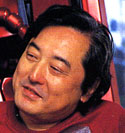
Okawara Kunio

Credits: Daitarn 3, Mobile Suit Gundam, Z Gundam, Gundam ZZ, Gundam F91, V Gundam, G Gundam, Gundam Wing, Gundam Wing Endless Waltz, Gundam X, G-Saviour, Turn A Gundam, 08th MS Team, Gundam SEED, Round Vernian Vifam, SPT Layzner, Metal Armor Dragonar, Fang of the Sun Dougram, Armored Trooper Votoms, Brave King Gaogaigar, Xabungle, Zambot 3, Legendary Giant Ideon, Betterman
Okawara has a list of credits that is impressive by anyone’s standards. He designed all of the mecha from the 1978 TV series Mobile Suit Gundam. Many consider him to be the grandfather of "realistic" mecha (as opposed to the super robots of the 70’s). Okawara stays active today contributing designs to most of the new Gundam series and many other mecha shows as well.
Okawara has been in the business for so long that his work has inspired many mecha designers who came after him. As a result, his design style is difficult to define. It would be better to say it is the "basic style" that most of today’s designers are variants of.
Famous Designs: RX-78-2 Gundam, MS-06F Zaku II
Shiro Masamune

Credits: Appleseed, Dominion, Orion, Ghost in the Shell, Black Magic, Black Magic M-66, Intron Depot artbook series, Gundress
Shiro uses a pen name and doesn’t allow photographs or visits to his studio. Despite his distaste for personal publicity one can see from his interviews and essays that he’s a warm person with a good sense of humor and proper sense of proportion. His hobbies include observing and studying spiders and reading scientific books and articles. His interest in spiders has shown up a number of times in his mechanical designs.
Born in Kobe City, Hyogo Prefecture on November 23, 1961 Shiro liked to take technical manuals into the mountains or down to the seashore to copy diagrams while in elementary school. He graduated from Osaka University of Arts with a degree in oil painting and self-published his first manga Black Magic in 1983 while still a student. His professional debut came with the first book of Appleseed in 1985. Since then he’s created a number of manga titles, some animation as well as a lot of freelance artwork.
Shiro’s mechanical designs are inimitable. His intuitive knowledge of mechanics and scientific principles coupled with his natural talents in art and illustration have resulted in a wealth of science-fiction designs and stories that the world is only now beginning to discover. Shiro has said in essays that he dislikes the giant robots that have become a staple of science-fiction in Japan due to their implausibility. However, he has nothing against smaller ones! Shiro designs display complex curves and very detailed mechanics.
Famous Designs: Bonaparte T1, Fuchikoma
Akitaka Mika 
Credits: Cruise Chaser Blasty, ZZ Gundam, Gundam 0080, Gundam 0083, V Gundam, Martian Successor Nadesico, Gundam Girls, Galaxy Fraulein Yuna, Silent Mobius (movies 1 & 2), Five Star Stories (anime), Transformers (toy line)
Akitaka is another veteran Gundam designer beginning his numerous contributions with mechanical designs for the TV series Gundam ZZ. In recent years Akitaka has become well known for his MS Girls illustrations that depict young girls wearing armor that resemble specific mobile suits from Gundam stories. Many fans have a place in their heart for Akitaka because it was he who created the Gerbera Tetra and the Neue Ziel from Gundam 0083.
Born on April 17, 1964 Akitaka’s professional debut was the mechanical designs of Cruise Chaser Blasty (by the way, if any of you can sell me or help me find mechanical art from that series I’d be much obliged). Akitaka has worked together with Katoki Hajime on many projects. His style usually consists of smooth curves and rounded surfaces.
Famous Designs: AMX-002 (AMA-X2) Neue Ziel, MSZ-010 ZZ Gundam (although he didn’t design the head)
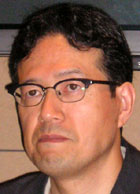
interview 1
Aramaki Shinji 
Credits: AD Police Files (OAV), Ai No Kusabi (OAV), Appleseed Movie, Armitage: Dual-Matrix (movie), Astro Boy [2003] (TV), Bubblegum Crisis (OAV), Bubblegum Crisis: Tokyo 2040 (TV), Fullmetal Alchemist (TV), Gasaraki (TV), Gekito! Crush Gear Turbo (TV), Genesis Climber Mospeada (TV), Genesis Survivor Gaiarth (OAV), Genocyber (OAV), Madox-01 (OAV), MASK (American TV), Megazone 23 (OAV), Megazone 23 Part 2 (OAV), Megazone 23 Part 3 (OAV), Mobile Suit Gundam MS IGLOO: Apocalypse 0079 (OAV), Mobile Suit Gundam MS IGLOO: The Hidden One Year War (movies), Naruto (movie), s-CRY-ed (TV), Witch Hunter Robin (TV), Wolf’s Rain (OAV), Wolf’s Rain (TV)
Aramaki Shinji is known as the Motorcycle King to many anime fans as it was he who designed many of the most popular motorcyles in anime. The Mospeadas from Genesis Climber Mospeada and the Garlands from Megazone 23’s three installments were his designs. He doesn’t stop at motorcycles, though. Aramaki has designed many excellent machines for anime since the 80’s and even though he’s directed and written original stories for many anime projects he still does mechanical design quite often.
Born on October 2, 1960 in Kyushu. Aramaki presides over Art Base Baku with three friends.
Famous Designs: VRO52-T Mospeada, Garland
Fujita Kazumi 
Credits: Z Gundam, Gundam ZZ, Tyrant Sword of Neofalia, Macross II, Quo Vadis (video game), King of Braves Gao Gai Gar, Escaflowne the Movie (art director)
Fujita designed, together with Okawara, many of the Z Gundam and Gundam ZZ mobile suits.
Famous Designs: RX-160 Byalant, PMX-000 Messala
Hataike Hiroyuki 
Credits: Z Gundam, ZZ Gundam, Aura Battler Dunbine 2: Tale of Neo Byston Well, Armor Trooper Votoms (novel), Detonator Orgun, Wares Saga: 1092, D-1 Devastator, NG Lamune 40 Fires, Bastard! (OAV), Adieu:Legend of Ryu Knights, El Hazard: The Magnificent World, Vision of Escaflowne, Outlaw Star, Angel Links
Haitake started out as a designer for fanzines and illustrator for magazines such as Newtype and B-Club. He also illustrated CD covers for Studio Sunrise. He worked as a clean up artist and animator for shows like Z Gundam and Gundam Double Zeta. His first animation debut was as character designer, animation director and one of the conceptual artists for Aura Battler Dunbine 2: Tale of Neo Byston Well. After that he illustrated for novels. One of them was Armor Trooper Votoms: The Blue Knight. He then worked on the novel/game series Wares Saga: 1092 as the character/mechanical designer and illustrator. He was a mechanical design supervisor on the OAV series D-1 Devastator. He then met up with Takehiko Ito and worked a bit as a concept designer for his own work, NG Lamune 40 Fires. In 1992 they would form "Studio Morning Star" which has produced everything from manga to doujinshi and even designed projects. His more independent work was as a visual designer for the OAV series Bastard! He worked on the TV and OAV series Adieu:Legend of Ryu Knights as a character/mechanical designer and supervisor and as a visual conceptualist on El Hazard: The Magnificent World. He was an assistant designer on Vision of Escaflowne. He and Takehiko Ito’s pride and joy, Future Generation Hero: Outlaw Star was then picked up by Sunrise to be produced and Hataike helmed the position as the original character designer and concept designer.
Famous Designs: Detonator Orgun, Niki Vashumaaru
Ishigaki Junya 
Credits: Exkaiser, Gundam Wing, GPX Cyber Formula, Gundam F91, Gundam 0083, V Gundam, Gundam X, 08th MS Team, Iron League, Ryu Knight, Escaflowne, Outlaw Star, DT Eitoron, Eatman 98, Turn ? Gundam, King of Braves Gaogaigar Final, Angelic Layer, Zone of the Enders Dolores, Heat Guy J, Macross Zero, Xenogears (game), Xenosaga Episode 1 (game), SD Gundam G-Generation 0 (game), SD Gundam G-Generation F (game), Surveillance (game), G-Breaker (game), Gundam Wing Episode Zero (manga), Gundam Wing Battlefield of Pacifist (manga)
Ishigaki Junya was born on November 11th, 1967. His professional debut was as a guest mecha designer for Exkaiser in 1990. His artistic talents encompass a wide range of subjects. From standard Gundam-style mecha to fantastical animals to floating fortresses, Ishigaki can handle it all. His work on Xenosaga Episode I demonstrates his ability to handle complex and unorthodox mecha design. He is affiliated with Studio Trapezoid.
Famous Designs: WMS-03 Maganac, SPA-51 Cannon Illfuto
Izubuchi Yutaka 
Credits: Mobile Police Patlabor, Gundam 0080, Gundam Char’s Counterattack, Gundam Wing (costume design), Record of Lodoss War, Xabungle, Dunbine, Votoms, Gasaraki, Cowboy Bebop the Movie (storyboard), Escaflowne the Movie (armor design consultant), Rahxephon
Izubuchi is a talented artist who has worked on mechanical designs, character designs and backgrounds in the animation industry for some time. His redesigns of older mobile suits for Gundam 0080 were quite popular and have been re-used many times since. Izubuchi has shown himself to be quite versatile in his design skills. From the organic mecha of Dunbine to the realistic TA of Gasaraki, the dragons of Lodoss War to the sleek mobile suits of Char’s Counterattack, Izubuchi has shown that he can create designs that fit any project.
Born on December 8, 1958 Izubuchi is a founding member of the 5-person company Headgear. Recently Izubuchi has finally stepped into the director’s chair to help create the TV series Rahxephon.
Famous Designs: RX-93 Nu Gundam, AV-98 Ingram "Alphonse"
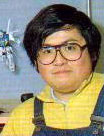
Kobayashi Makoto 
Credits: Z Gundam, Gundam ZZ, Dragon’s Heaven, AS Wars, Venus Wars (OAV), Gravion (production design), Last Exile (production design), Giant Robo (conceptual design)
Kobayashi worked on Z Gundam and Gundam ZZ producing some excellent designs like the Bound Doc and Marasai. His high degree of detail on both mobile suit inner mechanics and space ships showcases his skills. Kobayashi is also an expert model builder. His models and dioramas have been featured in the pages of Hobby Japan many times.
Famous Designs: NRX-055 Bound Doc, RMS-108 Marasai
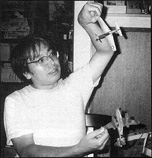
Kondo Kazuhisa 
Credits: Mobile Suit Gundam 0079 (manga), MS Senki, Side Story of Gundam Z
Born in Toyota City, Aichi Prefecture on April 2, 1959 Kondo has worked primarily in manga. He worked as an assistant for 5 or 6 years to other manga artists and then struck out on his own in the pages of Comic Bom Bom. Kondo has been hired to produce many Gundam comics and color artworks. His hobbies include plastic modeling and an avid interest in World War II airplanes.
Kondo’s designs have a gritty, weathered look to them that stands out among the squeaky-clean images of most other mecha designers. Most of his mechs look like they’ve been through a few wars and a lot of muddy weather. World War II seems to be an element in Kondo’s designs. Many of the mobile suits he’s designed or re-designed from other series have heavily armored metal skirts that resemble the overcoats worn by soldiers in the field in 1940’s Europe.
Famous Designs: MAN-010 G-3 (Gei Dorai), TMS-007X Z-Gustav
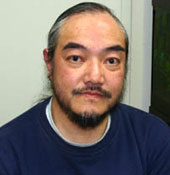
Miyatake Kazutaka 
Credits: Super Dimensions Fortress Macross, Macross: Do You Remember Love (movie), Super Dimensions Century Orguss, Aura Battler Dunbine, Crusher Joe OAV’s, Angel Links, Gunbuster, Dirty Pair Flash, Dirty Pair: Project Eden, Dirty Pair: Flight 005 Conspiracy, Macross 7, Macross Flash Back 2012, Macross II, Macross Plus, Macross Zero, Mai-Hime, MD Geist II: Death Force, Mobile Suit Gundam Seed, RahXephon, Sousei no Aquarion, Starship Troopers OAV, Submarine 707R
Miyatake Kazutaka seems to be the most easily overlooked man in mecha design despite being a prolific artist. His early work includes a large number of the mecha from Aura Battler Dunbine and most of the mecha/starships from Super Dimensions Fortress Macross. He has displayed a versatile style and attention to detail that is impressive to behold. He has been described as the silent backbone of Studio Nue.
Famous Designs: SDF-1 Macross, YF-21
Moriki Yasuhiro 
Credits: Ninja Senshi Tobikage, Fight! Iczer-1, Hagane No Oni (Demon Of Steel), Vampire Princess Miyu, Hades Project Zeorymer, Adventure! Iczer-3, Silent Mbius (TV and movies), D-1 Devastator, Orguss 02, Earthian, Magic Knight Rayearth, Onegai Teacher (TV), Martian Successor Nadesico (TV and movie), Shin-Kon Gattai Godannar (TV), Crest of the Stars (TV) 1999, Banner of the Stars (TV) 2000, Sonic X (TV) 2003, Banner of the Stars (TV), Banner of the Stars II (TV), Choujoushin Gravion (TV), Choujoushin Gravion Zwei (TV), Lily C.A.T. (movie), Masou Kishin Psybuster (TV), Scryed (TV), Yumeria (TV), Gundam: Hathaway’s Flash (novel), Golden Warrior Iczer-1 (manga), Legend of Iczer (manga), Godzilla 1990 (manga), Doll (manga), Xardion (video game), Sakura Taisen (video game)
Moriki Yasuhiro was born on September 25th, 1963. His debut work was on the TV show Ninja Senshi Tobikage. His designs usually have an ornate, fanciful look. Not many mecha designers have mastered making their designs look dramatic but Moriki manages it nicely.
Famous Designs: Zeorymer, RX-105 Xi Gundam

Ohata Koichi 
Credits: Borgman, Aim for the Top! (Gunbuster), Macross II, Genocyber, MD Geist, Dangaioh, Super High Speed Galvion (TV 1984)
Perhaps best known for creating the Gunbuster from Aim for the Top! and the re-fashioned Valkyries from Macross II, Ohata seems to draw much inspiration from nature - especially insects.
Famous Designs: Gunbuster, VF2-SS Valkyrie II
Okubo Junji 
Credits: Gundam: For the Barrel, Steel Battalion (video game), Appleseed: Ex Machina, Infinite Line (video game)
A relatively new mecha designer that has approached the task with an almost revolutionary zeal. Starting out on the brilliant Gundam re-make "For The Barrel" he later worked on numerous games such as Capcom’s "Steel Battalion". His designs are forcibly realistic and have a unique aesthetic when compared to other more contemporary designers. He’s also one of the first designers to identify elements of "keren" in Japanese mecha design. Recently he worked on the new Appleseed few, Ex Machina, designing many of the weapons and on the upcoming Nintendo DS game, Infinite Line, creating the numerous spaceship designs.
Famous Designs: Gunboy Wilbur (For The Barrel), Decider (Steel Battalion)
Oobari Masami 
Credits: Dancougar (1985), Fight! Iczer 1 (1985), Metal Armor Dragonar (1987/88), Dangaioh (1987), Bubblegum Crisis ep. 5 & 6 (1988/89), Exkaizer (1990/91), Faibaado (1991/92), Detonator Orgun (1991), Macross II (1992), Da Gaan (1992/93), Tekkaman Blade (1992/93), Might Gain (1993/94), Legend of the Hungry Wolf (1994), Magic Knight Rayearth (TV 1994/95), Toshinden (1996), Gowkaizer (1996), VIRUS Buster Serge (1997), Voogie’s Angel (1997), wei kreuz (1998), Dangaizer 3 (1999), Ordian (2000), Gravion, Gravion Zwei, Machine Robo, Le-Deus, Demon of Steel, Fatal Fury, D-1 Devestator
Oobari was born January 24th, 1966 (and his blood type is AB). He’s been in the mecha animation industry since its mid-80’s heyday. His works include the opening credits for many TV shows. He’s done both mecha design and character design for many projects. His unique artistic style make his mecha designs look alive and capture the aura of a grizzled warrior.
Famous Designs: Dangaioh, Dancougar
Yanase Takayuki 
Credits: Gundam 00
A new designer that started out in the Japanese industry, namely at the former Squaresoft and later From Software. His most iconic work has been for Gundam 00, where he designed the Kyrios, Dynames and Virtue mecha (as well as the Keldim, Arios and Selvii). He’s also contributed a large amount to the Super Robot Wars series, creating many of the newer OG mecha. Despite landing the lead design for a Gundam series at a young age, Yanase isn’t one for personal publicity. His designwork has often been compared to Katoki’s.
Famous Designs: Kyrios, Valhawk
